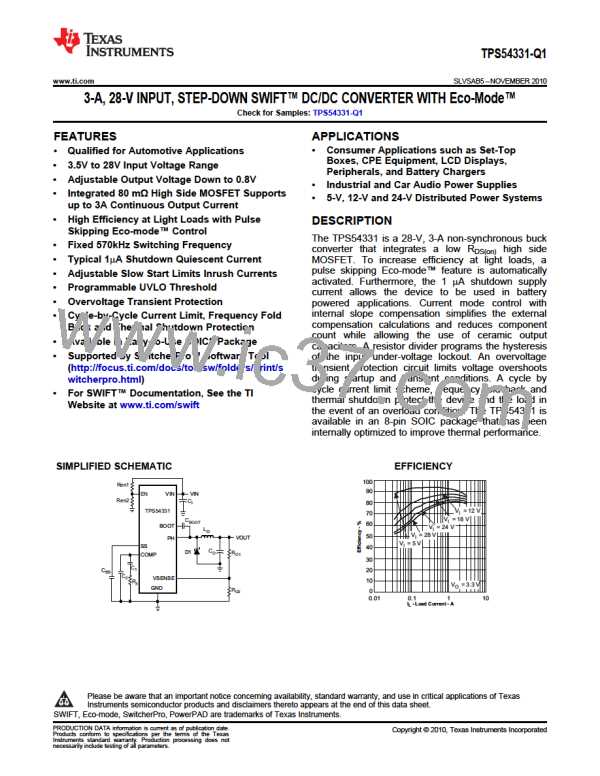TPS54331-Q1
SLVSAB5 –NOVEMBER 2010
www.ti.com
The maximum ESR of the output capacitor can be determined from the amount of allowable output ripple as
specified in the initial design parameters. The contribution to the output ripple voltage due to ESR is the inductor
ripple current times the ESR of the output filter, so the maximum specified ESR as listed in the capacitor data
sheet is given by Equation 13
D -0.5
VOPPMAX
(
)
4 ´ FSW ´ CO
ESRmax
=
-
ILPP
(13)
Where VOPPMAX is the desired maximum peak-to-peak output ripple. The maximum RMS ripple current in the
output capacitor is given by Equation 14.
æ
ç
ö
÷
VOUT × V
- VOUT
(
)
× LOUT × FSW × NC
IN(MAX)
1
ICOUT(RMS)
=
×
ç
÷
V
12
IN(MAX)
è
ø
(14)
For this design example, two 47-mF ceramic output capacitors are chosen for C8 and C9. These are TDK
C3216X5R0J476MT, rated at 6.3 V with a maximum ESR of 2 mΩ and a ripple current rating in excess of 3 A.
The calculated total RMS ripple current is 161 mA ( 80.6 mA each) and the maximum total ESR required is 43
mΩ. These output capacitors exceed the requirements by a wide margin and will result in a reliable,
high-performance design. it is important to note that the actual capacitance in circuit may be less than the
catalog value when the output is operating at the desired output of 3.3 V The selected output capacitor must be
rated for a voltage greater than the desired output voltage plus ½ the ripple voltage. Any derating amount must
also be included. Other capacitor types work well with the TPS54331, depending on the needs of the application.
COMPENSATION COMPONENTS
The external compensation used with the TPS54331 allows for a wide range of output filter configurations. A
large range of capacitor values and types of dielectric are supported. The design example uses ceramic X5R
dielectric output capacitors, but other types are supported.
A Type II compensation scheme is recommended for the TPS54331. The compensation components are chosen
to set the desired closed loop cross over frequency and phase margin for output filter components. The type II
compensation has the following characteristics; a dc gain component, a low frequency pole, and a mid frequency
zero / pole pair.
The dc gain is determined by Equation 15:
Vggm ´ VREF
GDC
=
VO
(15)
Where:
Vggm = 800
VREF = 0.8 V
The low-frequency pole is determined by Equation 16:
VPO = 1/ 2 ´ p ´ R
(
´CZ
)
OO
(16)
(17)
(18)
The mid-frequency zero is determined by Equation 17:
FZ1 = 1/ 2 ´ p ´ R ´CZ
(
)
Z
And, the mid-frequency pole is given by Equation 18:
= 1/ 2 ´ p ´ R ´CP
F
(
)
P1
Z
The first step is to choose the closed loop crossover frequency. In general, the closed-loop crossover frequency
should be less than 1/8 of the minimum operating frequency, but for the TPS54331it is recommended that the
maximum closed loop crossover frequency be not greater than 25 kHz. Next, the required gain and phase boost
of the crossover network needs to be calculated. By definition, the gain of the compensation network must be the
inverse of the gain of the modulator and output filter. For this design example, where the ESR zero is much
higher than the closed loop crossover frequency, the gain of the modulator and output filter can be approximated
by Equation 19:
14
Submit Documentation Feedback
Copyright © 2010, Texas Instruments Incorporated
Product Folder Link(s): TPS54331-Q1

 TI [ TEXAS INSTRUMENTS ]
TI [ TEXAS INSTRUMENTS ]